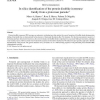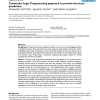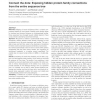15 search results - page 1 / 3 » A simplified approach to disulfide connectivity prediction f... |
BMCBI
2008
13 years 8 months ago
2008
Background: Prediction of disulfide bridges from protein sequences is useful for characterizing structural and functional properties of proteins. Several methods based on differen...
CANDC
2008
ACM
13 years 8 months ago
2008
ACM
Protein disulfide isomerase (PDI) enzymes are eukaryotic oxidoreductases that catalyze the correct formation of disulfide bonds during protein folding. Structurally they are chara...
BMCBI
2004
13 years 8 months ago
2004
Background: The protein structure prediction problem is one of the most challenging problems in biological sciences. Many approaches have been proposed using database information ...
ECCB
2008
IEEE
14 years 3 months ago
2008
IEEE
Motivation: Mapping of remote evolutionary links is a classic computational problem of much interest. Relating protein families allows for functional and structural inference on u...
JCB
2007
13 years 8 months ago
2007
In our recent work, a new approach to establish sequence relatedness, by walking through the protein sequence space, was introduced. The sequence space is built from 20 amino acid...



